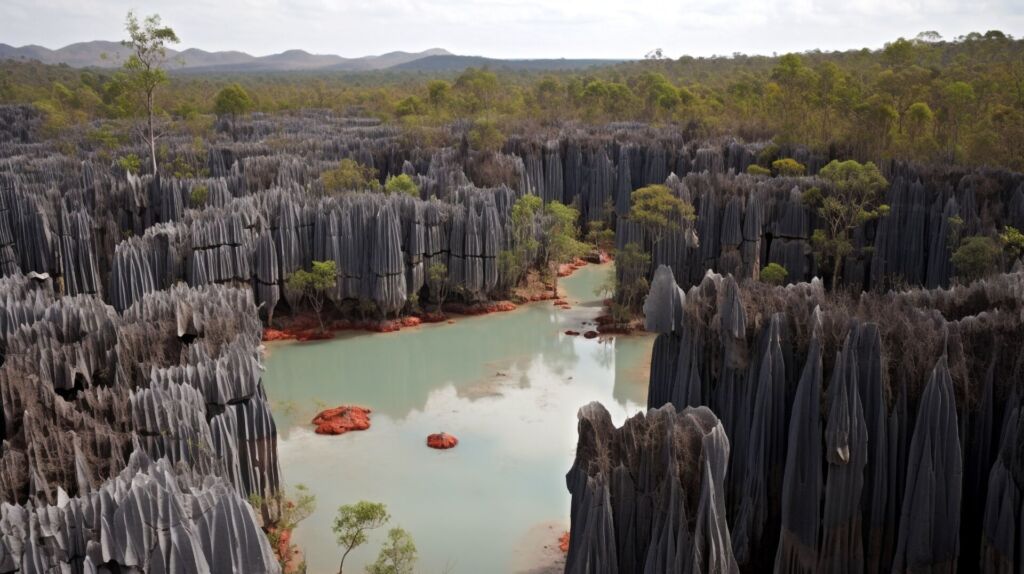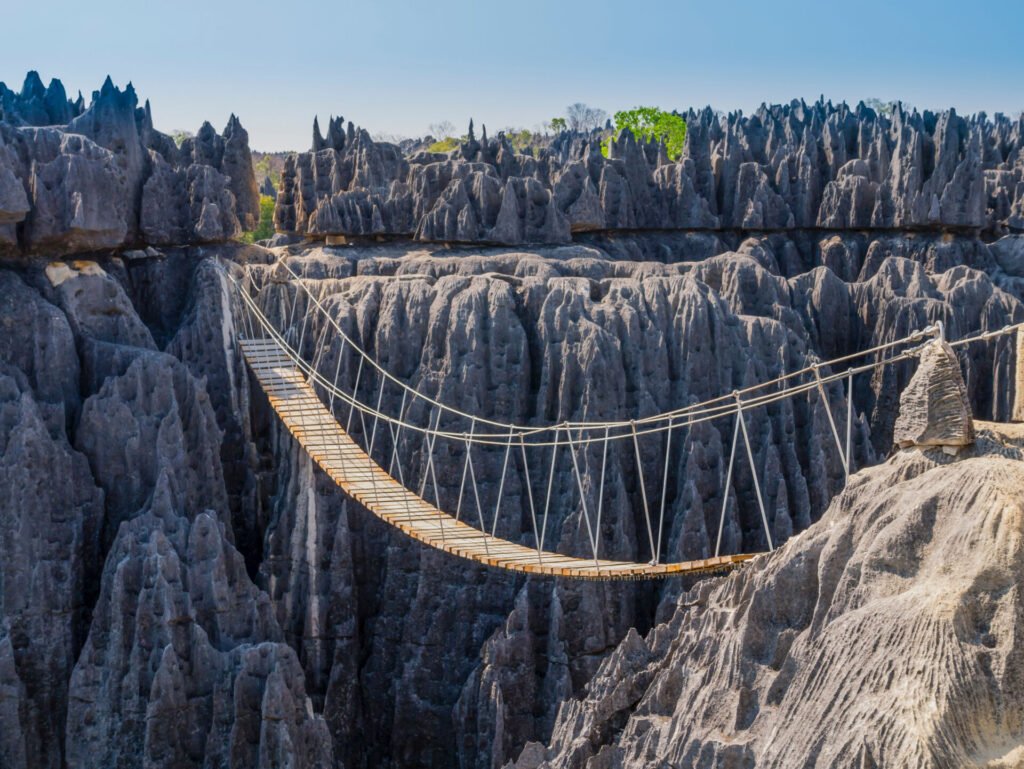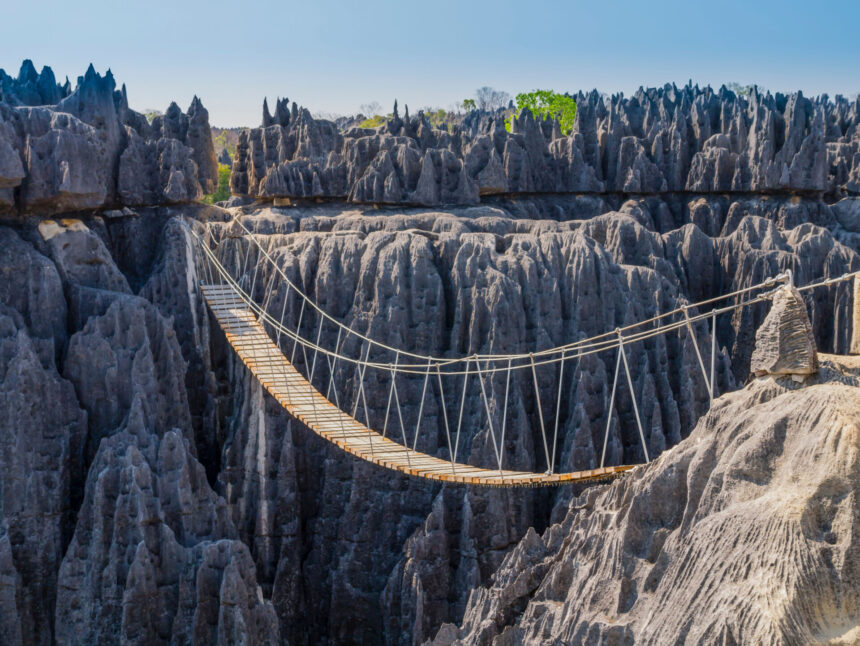Introduction:
Imagine a realm where nature wields its power with breathtaking audacity. A landscape where razor-sharp limestone spires pierce the sky, their jagged edges glinting under the relentless sun. This is Tsingy de Bemaraha, Madagascar’s stone forest, a 100-mile expanse of otherworldly wonder.

This extraordinary region is where the earth itself seems to defy gravity. A vast labyrinth of canyons twists and turns, their depths shrouded in shadow. Here, the word ‘tsingy,’ meaning “where one cannot walk barefoot,” becomes vividly real. Each step is a thrilling dance between danger and awe. Designated as a UNESCO World Heritage Site, the Tsingy de Bemaraha and Madagascar stone forest harbor an ecosystem as unique as its unforgiving landscape.
Within this harsh haven of stone, life flourishes with surprising resilience. Lemurs cling precariously to vertical cliffs, their eyes gleaming from hidden crevices. Orchids with delicate blooms find purchase in the tiniest of cracks. Tsingy de Bemaraha is a testament to nature’s tenacious grip, a surreal masterpiece that will forever alter your perception of our planet.
The Formation of an Otherworldly Landscape:
Geology at Work
The Tsingy de Bemaraha and Madagascar stone forest bear witness to millions of years of geological sculpting. The journey began roughly 200 million years ago – this region lay beneath a warm, shallow sea. Gradually, layers of fossilized shell and coral compressed into thick limestone beds.
Tectonic forces intervened, upheaving the seabed and exposing the limestone to the elements. Relentless monsoon rains and acidic groundwater began their determined work on the vulnerable rock. Softer areas dissolved, leaving a mesmerizing network of harder limestone behind. This process continues today, further shaping this extraordinary landscape.
A Stone Labyrinth
The result of this relentless erosion is both awe-inspiring and intimidating. Razor-sharp pinnacles rise like ancient spires. This ‘tsingy’ can reach over 300 feet, forming a formidable stone forest. Below, deep crevasses and hidden canyons zigzag throughout the reserve, creating a complex and sometimes treacherous maze.
Scale and Size
Tsingy de Bemaraha National Park and the adjoining Strict Nature Reserve cover a staggering expanse. The unique ‘tsingy’ formations stretch over 100 miles within these protected areas. Among the dramatic features within the reserve are:
- The Great Tsingy: The most well-known section, featuring the tallest and most densely packed stone spires.
- The Little Tsingy: Smaller yet equally intricate formations offering adventurous exploration.
The Tsingy de Bemaraha and Madagascar stone forest are a testament to nature’s patient artistry, creating a beautiful and forbidding landscape.

Life Finds a Way: The Biodiversity of Tsingy
The formidable landscape of the Tsingy de Bemaraha and Madagascar stone forest might seem inhospitable. Yet, life has found astonishing ways to survive and thrive within this stone labyrinth. From the agile lemurs navigating vertical cliffs to the vibrant reptiles camouflaged amongst the pinnacles, this ecosystem is a testament to nature’s resilience.
Lemurs – Stars of the Show
With their expressive eyes and playful antics, lemurs are Madagascar’s charismatic icons. Tsingy de Bemaraha is a sanctuary for several species, including:
- Deckens’ Sifaka: Their powerful legs propel them across astonishing distances between the stone spires.
- Crowned Lemur: These agile climbers find refuge in the higher reaches of the Tsingy.
- Milne-Edwards Sportive Lemur: A nocturnal resident emerging under the veil of darkness.
These lemurs showcase incredible adaptations to the Tsingy’s harsh conditions, from specialized diets to their remarkable climbing abilities.
Reptile Wonders
The Tsingy de Bemaraha and Madagascar stone forest are havens for a mesmerizing array of reptiles perfectly adapted to this unique environment.
- Panther Chameleons: Masters of disguise with their color-changing skin and independent eyes.
- Leaf-Tailed Geckos: Blending seamlessly with tree bark and even the rock itself.
- Madagascar Ground Boa: This snake is adept at navigating the tsingy’s crevices in search of prey.
Botanical Treasures
Even plant life defies expectations. Orchids burst into bloom from narrow cracks. Drought-resistant baobab trees stand sentinel over the landscape. The Tsingy de Bemaraha is a masterclass in microhabitats: tiny pockets where humidity and nutrients allow diverse plant life to cling to the unforgiving stone.
The Unseen World
The drama of the Tsingy doesn’t end at the surface. Here, extensive cave systems hold their secrets. Blind fish have adapted to survive in the eternal darkness. Bats roost in the depths, venturing out under the cover of night. The cave network offers a fascinating glimpse into another hidden layer of the rich biodiversity of the Tsingy de Bemaraha and Madagascar stone forest.
Exploring Tsingy de Bemaraha: An Adventure Awaits
The Tsingy de Bemaraha and Madagascar stone forest beckon those with a spirit of discovery. Be warned, this is not a place for casual strolling. Exploration here demands a good level of fitness, a tolerance for heights, and a healthy dose of adventurous spirit. The reward? A sense of accomplishment unlike any other.
Challenges and Rewards
Exploring the Tsingy de Bemaraha is a physically demanding experience. Trails involve scrambling over sharp rocks, traversing narrow ridges, and negotiating vertical ladders. Yet, every challenging climb every narrow passage traversed, brings an unparalleled sense of exhilaration and awe.
Trail Options
Within the protected area, dedicated trails offer visitors a taste of the Tsingy’s diverse formations:
- Andadoany Circuit (Great Tsingy): This moderately challenging trail takes you into the heart of the most iconic stone formations. Here, suspended bridges offer dizzying perspectives of the canyon below.
- Broadway Circuit (Little Tsingy): An excellent choice for getting up close with the intricate formations of the Little Tsingy.
- Ranoky Circuit (Great Tsingy): A longer, more demanding trek venturing deeper into the wilderness of the Tsingy de Bemaraha.
Beyond the Trails
Adventure in the Tsingy de Bemaraha isn’t limited to the surface, for the truly daring, intricate cave systems offer a chance to delve into the reserve’s hidden depths. Qualified guides are essential for these subterranean explorations.
Are you seeking a slightly less intense experience? Boat tours along the Manambolo River offer stunning views of the Tsingy rising dramatically from the riverbanks.
The Tsingy de Bemaraha and Madagascar stone forests demand respect and preparation. But for the intrepid traveler, this unique environment promises an unforgettable journey of discovery and a profound appreciation for the transformative power of nature.

Conservation and Responsible Tourism
The Tsingy de Bemaraha’s otherworldly beauty masks a fragile ecosystem. While its spires may seem impervious, this unique environment faces threats:
- Deforestation: Expanding agriculture and logging endangers the reserve’s forests, isolating its unique biodiversity.
- Potential Mining: The reserve’s boundaries hold potential for mineral extraction, posing future risks.
- Unsustainable practices: Without careful management, unregulated tourism could damage the delicate formations and disturb wildlife.
The Role of Tourism
Paradoxically, responsible tourism can be a vital conservation tool for the Tsingy de Bemaraha. Income generated through park visits helps fund protection efforts, research, and community initiatives. The very presence of tourists can deter some illegal activities.
Sustainable Practices: How Travelers Can Help
Every visitor to the Tsingy de Bemaraha has the power to make a positive impact. Here’s how:
- Hire Local Guides: Their knowledge is invaluable, and their income directly supports the surrounding communities invested in the reserve’s protection.
- Stay on Designated Trails: This minimizes erosion and protects the intricate, tsingy formations.
- Respect Wildlife: Observe animals from a distance. Never feed or attempt to touch them.
- Pack Out Your Trash: Leave no trace behind.
Practical Tips for Visiting Tsingy
The allure of Tsingy de Bemaraha is undeniable, yet reaching this geological wonder requires careful planning. Here’s what you need to know:
Best Time to Visit
- Dry Season (May – October): This period offers the most pleasant weather and the safest conditions for exploring the Tsingy. Trails are more accessible, and risks of flooding are reduced.
Reaching Tsingy
- Flights: The nearest town with a commercial airport is Morondava. From here, you’ll need to arrange onward transportation.
- Road Journey: The drive from Morondava to the Tsingy de Bemaraha park entrance is long and arduous, typically on rough 4×4 tracks. Be prepared for an adventure, even before reaching the stone forest!
Guided Tours
Navigating the Tsingy de Bemaraha independently is not recommended. Experienced guides are essential for:
- Safety: They know the safest routes through the complex and sometimes hazardous terrain.
- Enrichment: Guides can share insights into the park’s geology, wildlife, and local culture.
- Access: Reputable guides will arrange permits and any necessary equipment.
What to Pack
- Sturdy Hiking Shoes: Trails are rough and uneven; proper footwear is crucial.
- Sun Protection: Hat, sunglasses, and sunscreen are a must.
- Plenty of Water: Dehydration is a risk – carry a refillable water bottle.
- Lightweight Layers: Temperatures can shift throughout the day.
- Headlamp: Essential if exploring caves.
The Tsingy de Bemaraha rewards intrepid travelers with a truly unforgettable experience. With some preparation and guidance, you’ll stand amongst the towering spires, forever in awe of nature’s extraordinary artistry.
Conclusion: A Wonder Worth Protecting
The Tsingy de Bemaraha isn’t merely a geological oddity. It’s a testament to the relentless sculpting power of time and the extraordinary resilience of life. Each limestone spire and hidden canyon offers a profound lesson in the intricate balance of our planet.
This unique environment isn’t invulnerable. It’s a reminder that even the most awe-inspiring natural wonders require careful stewardship. By choosing responsible travel and actively supporting conservation, we can help ensure that the Tsingy de Bemaraha continues to amaze and inspire future generations.
Your Journey Continues
Your experience with the Tsingy de Bemaraha doesn’t have to end when you leave this stone labyrinth. Here’s how you can stay engaged:
- Learn More: Discover the astounding biodiversity of Madagascar, home to creatures found nowhere else on Earth.
- Support Conservation: Research reputable organizations working to protect Madagascar’s unique ecosystems. Even small donations can make a difference.
The Tsingy de Bemaraha may seem like a world apart. Still, it’s inextricably linked to a much larger story – the extraordinary diversity of our planet and the responsibility we have to protect it. Let your journey through this stone forest catalyze a deeper appreciation of the natural world and a commitment to its preservation.
Call to Action: Share Your Wonders
Has the otherworldly beauty of the Tsingy de Bemaraha ignited your sense of wanderlust? It may have brought back memories of other unique natural wonders you’ve experienced across the globe. We want to hear from you!
- Share Your Stories: Have you encountered landscapes that defy description – places that left you in awe of nature’s power? Let us know in the comments below!
- Inspire Others: Your experiences can motivate others to seek out the extraordinary in our world.
- Celebrate Our Planet: Let’s use this space to appreciate the diverse beauty of Earth’s natural wonders, from towering rock formations to hidden underwater worlds.
The Tsingy de Bemaraha is a powerful reminder that there’s much more to discover in our incredible world. Let’s keep the conversation flowing about exploring and protecting these irreplaceable natural treasures.

